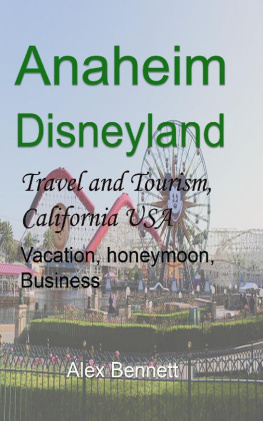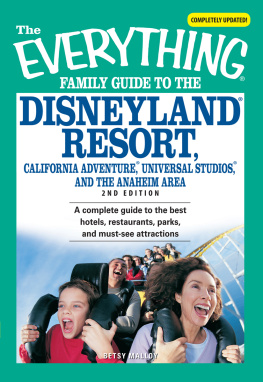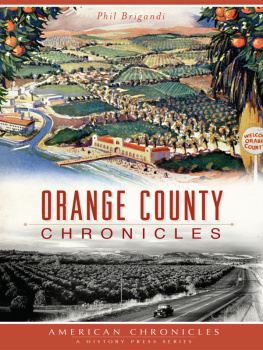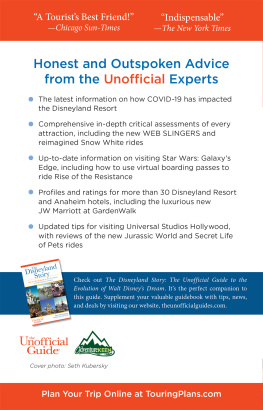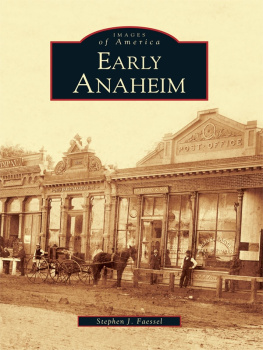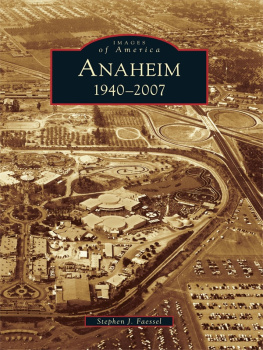Table of Contents
Anaheim- Disneyland Travel and Tourism, California USA
Vacation, honeymoon, Business.
Author
Alex Bennett
SONITTEC PUBLISHING.
All rights reserved. No part of this publication may be reproduced, distributed, or transmitted in any form or by any means, including photocopying, recording, or other electronic or mechanical methods, without the prior written permission of the publisher, except in the case of brief quotations embodied in critical reviews and certain other noncommercial uses permitted by copyright law. For permission requests, write to the publisher, addressed Attention: Permissions Coordinator, at the address below.
Copyright 2019 Sonittec Publishing
All Rights Reserved
First Printed: 2019.
Publisher
SONITTEC
College House, 2nd Floor
17 King Edwards Road
Ruislip, London
HA4 7AE
Summary
Traveling and Tourism
Tourism is a global industry, which involves people travelling across the world for a variety of reasons mainly recreation and sightseeing. When tourists decide where to travel, they often base their decisions on the attractions and situations in a city or country. Sometimes countries are in the midst of political unrest, such as war, civil war or terrorism. Tourists will avoid these destinations, choosing more peaceful destinations instead. However, while they are there, unforeseen situations may occur, such as tsunamis, natural disasters, diseases or accidents. It is important for tourism professionals and for tourists themselves to adequately prepare, through thorough research, before they (or their clients) leave on a journey.
Every country has sights of attractions and places of interest, some of which are not known that easy, and to discover them, you have to need a guide on the interested place, learn about local peoples attitude and relation with foreginers, it is important to know all these. This is the importance of Tourist Book Guide
Introduction
Known for 60 years as the home to Disneyland, Anaheim is pushing the idea that theres more for tourists to do and spend money on than ride on Space Mountain and snap a selfie with Mickey Mouse.
Among the new offerings are a food mall that was converted from an abandoned orange packing house and a brewery built within an old Packard car dealership. Five hotels with more than 1,000 rooms are set to open over the next 12 months, in addition to three hotels with 470 rooms that opened last year. The Anaheim Convention Center recently broke ground on a 200,000-square-foot expansion. A 600-room hotel with a 105,000-square-foot water park also is set to open in adjacent Garden Grove next year.
With taxes from hotels and Disney theme parks generating about half of the citys $286 million general fund, Anaheim officials are banking on the prospects that tourism will continue to flourish. The city welcomed 21.7 million visitors last year, up 16 percent from the previous year.
Anaheim bought 7 acres along Anaheim Boulevard about six blocks north of Disneyland and renovated decaying auto repair shops, a used-car lot and a smog check business to pave the way for the Anaheim Brewery and the Packing House food hall, which includes a juice bar, a sushi restaurant, a pizza place and a soul food joint.
Not to be left out, city and tourism officials in Garden Grove have big hopes for Great Wolf Lodge. A Wisconsin resort operator is building its first California all-suite hotel south of Disneyland with help from $47 million in city redevelopment funds. The woods-themed resort will feature a water park that will be almost all indoors and available only to overnight guests. Most water parks in the West are sprawling outdoor attractions.
The resort is expected to draw families with children ages 2 to 12 to spend several days in the hotel while visiting Disneyland and other Southern California attractions, said project spokeswoman Susan Storey.
About
Early History of Anaheim
Almost every locality has its history and romance, but we of California believe our state to have a particularly interesting history. Not only do our larger towns add much to this history but even the small towns add their share as well. Anaheim, not to be outdone by other small communities adds its share which is picturesque and romantic too.
Next to San Bernardino which was a Mormon colony, Anaheim is the oldest colony experiment in the state. Several Germans living in San Francisco became dissatisfied with the city and began to plan to leave. They proposed among themselves to purchase a tract of land, lay it out into small farms and engage in grape culture. So, accordingly, early in 1857 they began an investigation of different localities suitable for their proposed colony site.
These men under the leadership of one George Hansen, carefully looked over many sites and in September 1857, came to a final decision. A tract of land one and one half miles long by one and one quarter miles broad, lying southeast of Los Angeles twenty-eight miles and containing 1,165 acres was purchased from Pacifico Ontiveros at a price of $2 an acre.
This price included sufficient water privileges to insure an ample irrigation. The colonists became known as the Los Angeles Vineyard Company, because the land was purchased in Los Angeles county. The company was composed of fifty shareholders; was under the direction of a board of trustees in San Francisco and Los Angeles. The business was carried on by an auditing committee headed by John Frohling. As an aside it might be of interest here to mention that Miss Hammas whom Mr. Frohlin married was Anaheims first bride. Mrs. Frohling passed on only a few years ago [1923], but her house is still standing and is one of the few early landmarks of Anaheims history.
The project of the colonists was by far the most important that had ever been contemplated in the southland. Their vineyard was to be the largest vineyard in the world, there being none of such extent in Europe. The work of improving the tract began at once and the colonists were eagerly looking forward to the time when they could go to their new home. The necessity of having a name for that home arose. The stockholders of the colony met on January 13, 1858, at Leutgens Hotel in San Francisco for the purpose of choosing a name for their southland home.
A number of the colonists preferred to call it Anaberg, Ana for the Santa Ana river from which irrigation water was drawn and berg for the mountains in the distance. But Mr. [Theodore] Schmidt, father of Mrs. Dickel and Mrs. Turck, whom many of us know so well, proposed the name Anaheim combining Ana with home or heim, the German name for home. So Anaheim was named meaning Home by the Santa Ana River.
The work of preparing for a real home was pushed forward very vigorously at a daily expense of $216 for there were employed in all 88 men, 10 women, 84 horses, 7 plows and 17 wagons. Anaheim was divided into fifty lots of twenty acres each and fifty house lots with fourteen additional village lots which were reserved for a school house and such other public buildings as the colony might require. On each twenty acre lot eight acres were immediately set out to grapes and a few fruit trees.
A main ditch some seven miles long was dug to lead the irrigation waters over the whole area. Also 35 miles of subsidiary ditches and twenty-five feeders to these were dug. So we see the question of water supply did not cause the colonists the least anxiety for there was an abundance of water. Each lot was fenced by willows making thirty-five miles of inside fencing. The whole was surrounded by a hedge of 40,000 willow poles. These poles were planted one and one-half feet apart and strengthened by three horizontal poles and defended by a ditch four feet deep and six feet wide at the top, sloping to one foot in width at the bottom. These poles took root and grew making a living hedge of green around the community.

